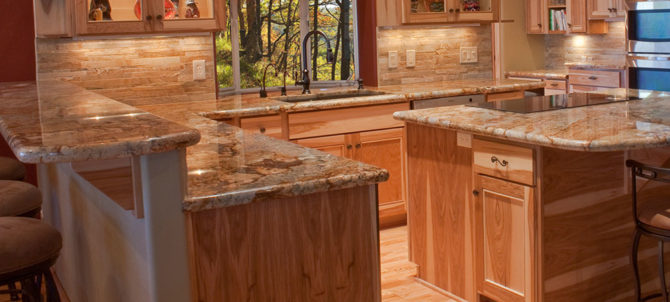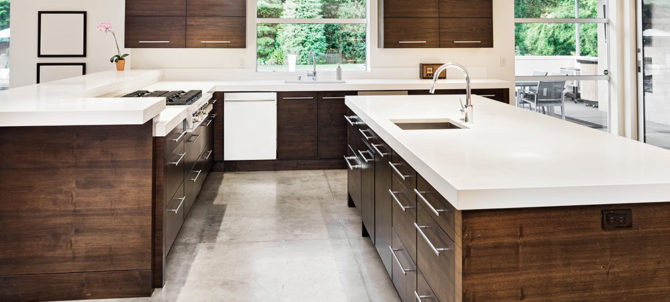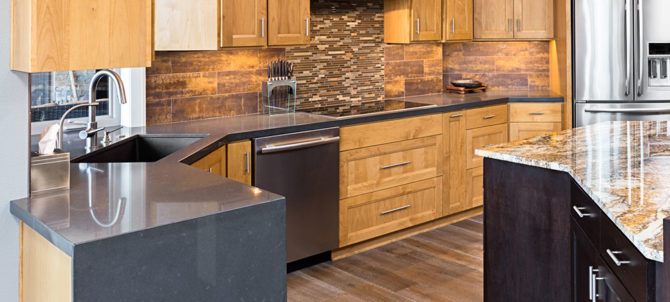
Whether you’re a homeowner or a renter, it makes sense to want to create a space that is visually appealing to you. However, home renovation projects can be expensive and almost impossible if you do not own the property.
If you’ve been considering changing bathroom, laundry room, or kitchen countertops, you may have encountered a peel-and-stick countertop cover while researching.
Before we go into this seemingly simple solution, here’s everything you need to know about peel-and-stick countertops. You will also know which applications they’re great for and when to avoid them.
What are peel-and-stick countertops?
Peel-and-stick countertops are a wallpaper-like material with a sticky backing that you can easily apply to your current countertops. They come in a range of colors and styles, such as faux marble, granite, gold, soapstone, and concrete.
Most peel-and-stick countertops are made of a PVC vinyl foundation with a printed picture or pattern. The production process is comparable to vinyl flooring, but the quality and durability aren’t as high.
Peel and stick countertops do not have the same level of differentiation, most likely because there are fewer prominent producers in the area.
When is it wise to go for peel-and-stick countertops?
Peel and stick countertops are more of a temporary remedy than a permanent one.
While this is the case, the counters are useful in some instances. For example, they’re a quick and inexpensive solution for outdated or damaged countertops, and they can serve as an interim cover-up while you save for the real thing.
They can also be adequate in auxiliary areas of the home, such as the basement or an extra bathroom.
The counters are also an excellent option for tenants who can’t pull out existing countertops. If you live in a rental house with outdated countertops or don’t like the current look, peel-and-stick countertops can be a low-cost, temporary approach to make the rental area feel more like your own.
The beauty is that the countertops can be easily removed when it’s time to move out.
How to apply and remove the countertops
If you decide to go this route, keep in mind that peel-and-stick countertops vary in quality. For the best quality, go with the thickest material available—veneers at least four millimeters thick—so that the product can withstand scratches and better disguise bumps and faults on your current countertops.
In terms of application, the process is quite simple but requires some patience. When buying the material, buy extra in case of mishaps and keep a squeegee on standby to remove air bubbles after installation.
For removal, heat from a hairdryer to one corner to melt the glue. You should slowly pull the counter up, heating and melting as you go.
To give you a sense of quality and longevity, most warranties last around five years. However, if the countertops are in a high-traffic area, the wear will most certainly occur considerably sooner, even with a higher-grade product.
Situations to avoid peel-and-stick countertops
These countertops are best suited for secondary, low-traffic areas of your home, where their poorer appearance and performance will be less noticeable. This calls for you to be cautious where you place the countertops.
As a rule of thumb, never place the countertop on a kitchen island countertop or your primary bathroom in a busy home. This is because they will quickly get damaged.
If your ultimate goal is to stay within a budget when designing and creating your dream kitchen or bathroom, you should know that there are numerous cost-cutting options worth trying initially.
A smart contractor or interior designer can assist you navigate that environment, and there is plenty of information available online that you can use to your advantage.
Peel and stick countertop best practices.
Once you’ve successfully placed your peel-and-stick countertop, make sure to clean and maintain it properly to keep it looking its best. Regular cleaning and maintenance will help extend the countertop’s lifespan and keep it in excellent condition.
Begin by washing off the countertop regularly using a soft cloth or sponge and a moderate, non-abrasive cleanser. Avoid harsh chemicals or abrasive cleansers, which might damage the surface or remove the protective covering.
To remove harder stains or spills, gently scrub brush or non-scratch scouring pad in conjunction with the mild cleanser. Scrub the area gently in a circular motion, taking care not to apply too much pressure, which may scrape the surface.
After cleaning, thoroughly rinse the countertop with water to eliminate any remaining cleaner residue. Wipe it dry with a clean cloth to avoid water spots or streaks from appearing.
When it comes to maintenance, it’s best to avoid placing hot pans or pots directly on the countertop surface, which can cause damage or discoloration. Always use trivets or hot pads to protect surfaces from heat.
Similarly, be mindful of sharp or abrasive things that may scratch the surface. Use cutting boards or another safe surface when dealing with knives or other instruments.
Regularly inspect the countertop’s edges and seams for signs of lifting or peeling. If problems arise, apply a small bit of glue or double-sided tape to keep them in place.
Parting shot
Peel and stick countertops can provide a low-cost, temporary “lipstick makeover” in rooms you don’t own, don’t use frequently, or can’t afford to renovate right now.
In all other circumstances, you’re probably better off investing extra in something that will withstand time and traffic.
The good thing is that you can choose from plenty of options. You can use granite countertops Raleigh, marble, and many other materials. Regardless of the ones you settle on, ensure they complement your home. You also should ensure they are installed by experienced contractors who know what they are doing.

